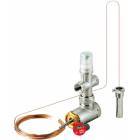Interception valves and I.S.P.E.S.L. standards
The interception valve requirements are defined in the ISPESL standards

The interception valves produced by GNALI BOCIA S.r.l. are manufactured on an original patented design using materials which guarantee reliability and durability – two essential factors for making your plants really safe.
These interception valves intervene in normal conditions - if the temperature is exceeded - or in the event of breakage of the heat probe with diathermic fluid leakage. They are therefore fail-safe.
These tools are calibrated and type-approved pursuant to the 'Raccolta 8' provisions issued by ISPESL (now INAIL, the National Workers' Compensation Authority), which also specifies the situations requiring the use of fuel interception valves in order to guarantee the safety of the plant.
These standards require that each valve is calibrated in the presence of an official appointed by the Authority and is identified by a plate bearing the valve serial number and locking the calibration device. A test certificate should accompany the valve and must be carefully kept along with the plant-related documentation.
The interception valves body is made from forged brass CW617N (OT58) which is machined and then chromed to guarantee resistance and durability in contact with the main fuels used: Diesel, LPG, Methane, Fuel Oils. All materials used, from the body to the nitrile rubber packing seals, have been chosen to guarantee durability of the product over tim
These interception valves intervene in normal conditions - if the temperature is exceeded - or in the event of breakage of the heat probe with diathermic fluid leakage. They are therefore fail-safe.
These tools are calibrated and type-approved pursuant to the 'Raccolta 8' provisions issued by ISPESL (now INAIL, the National Workers' Compensation Authority), which also specifies the situations requiring the use of fuel interception valves in order to guarantee the safety of the plant.
These standards require that each valve is calibrated in the presence of an official appointed by the Authority and is identified by a plate bearing the valve serial number and locking the calibration device. A test certificate should accompany the valve and must be carefully kept along with the plant-related documentation.
The interception valves body is made from forged brass CW617N (OT58) which is machined and then chromed to guarantee resistance and durability in contact with the main fuels used: Diesel, LPG, Methane, Fuel Oils. All materials used, from the body to the nitrile rubber packing seals, have been chosen to guarantee durability of the product over tim
14/05/2014
I contenuti di questo sito non hanno carattere di periodicità e non rappresentano 'prodotto editoriale'.








